英语动词的变化规则
- 格式:docx
- 大小:2.18 MB
- 文档页数:3
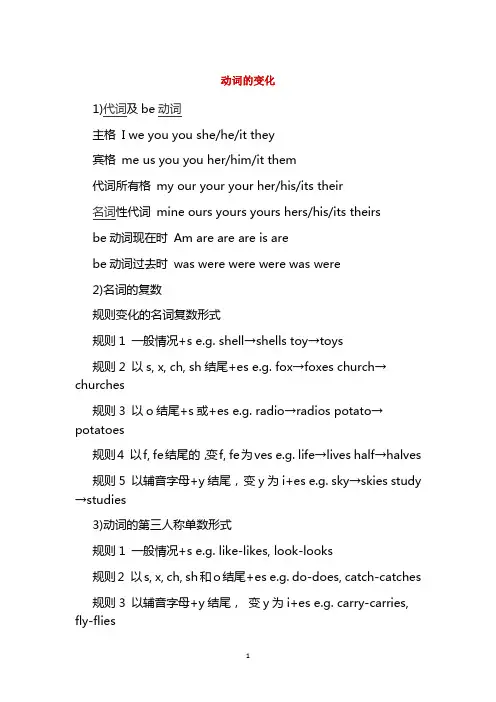
动词的变化1)代词及be动词主格I we you you she/he/it they宾格me us you you her/him/it them代词所有格my our your your her/his/its their名词性代词mine ours yours yours hers/his/its theirsbe动词现在时Am are are are is arebe动词过去时was were were were was were2)名词的复数规则变化的名词复数形式规则1 一般情况+s e.g. shell→shells toy→toys规则2 以s, x, ch, sh结尾+es e.g. fox→foxes church→churches规则3 以o结尾+s或+es e.g. radio→radios potato→potatoes规则4 以f, fe结尾的,变f, fe为ves e.g. life→lives half→halves 规则5 以辅音字母+y结尾,变y为i+es e.g. sky→skies study →studies3)动词的第三人称单数形式规则1 一般情况+s e.g. like-likes, look-looks规则2 以s, x, ch, sh和o结尾+es e.g. do-does, catch-catches 规则3 以辅音字母+y结尾,变y为i+es e.g. carry-carries, fly-flies4)动词现在分词规则1 一般动词加-ing e.g. look-looking, read-reading, play-playing规则2 以不发音的字母结尾的单词去e加-ing e.g.make-making, take-taking, arrive-arriving规则3 重读闭音节词结尾,即单词中只有一个元音字母,其后紧跟一个辅音字母的词,双写辅音字母再加-ing e. g. run-running, sit-sitting, get-getting, swim-swimming, stop-stopping5)动词过去式规则动词变化规则1一般动词加-ed e.g. look-looked,watch-watched, play-played规则2以e结尾的加-d e.g. make-maked, arrive-arrived规则3以辅音字母y结尾的变y为i加-ed cry-cried,carry-carried规则4重读闭音节词结尾,即单词中只有一个元音字母,其后紧跟一个辅音字母的词,双写辅音字母再加-ed stop-stopped 过去式的读音在清辅音后面(除外)读/t/ e.g. walked, jumped在浊辅音和元音后读/d/ e.g. washed, watched在/t/,/d/后读/id/ e.g. waited, hated6)形容词和副词的比较级和最高级比较级规则1一般加-er e.g. high-higher规则2以e结尾加-r nice-nicer规则3以辅音字母加y结尾,变y为i再加-er busy-busier规则4重读闭音节结尾,双写辅音字母再加-er fat-fatter最高级规则1一般加-est e.g. high-highest规则2以e结尾加-st nice-nicest规则3以辅音字母加y结尾,变y为i再加-est busy-busiest 规则4重读闭音节结尾,双写辅音字母再加--est fat-fattest7)常见缩写:is='s I am=I'm are='reis not=isn't /iznt/ are not=aren't /a:nt/do not=don'tdoes not=doesn'twas='sdid not=didn'tcan not=can'thave='vehas='shave not=haven'thas not=hasn'twill='llwill not=won'tshall not=shan't。
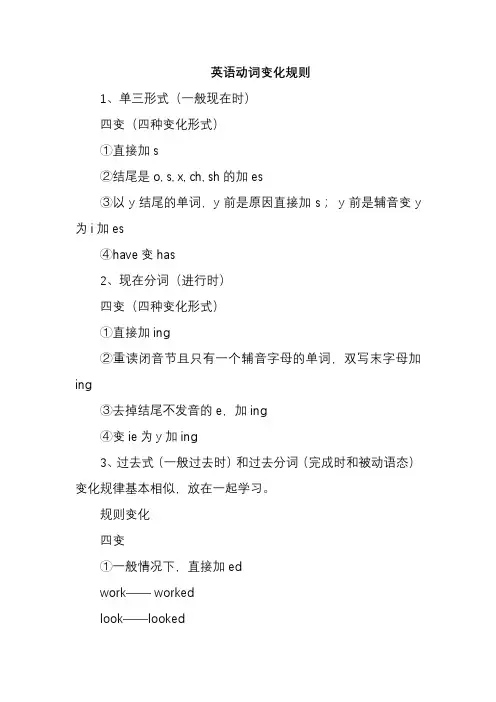
英语动词变化规则
1、单三形式(一般现在时)
四变(四种变化形式)
①直接加s
②结尾是o, s, x, ch, sh的加es
③以y结尾的单词,y前是原因直接加s;y前是辅音变y 为i加es
④have变has
2、现在分词(进行时)
四变(四种变化形式)
①直接加ing
②重读闭音节且只有一个辅音字母的单词,双写末字母加ing
③去掉结尾不发音的e,加ing
④变ie为y加ing
3、过去式(一般过去时)和过去分词(完成时和被动语态)变化规律基本相似,放在一起学习。
规则变化
四变
①一般情况下,直接加ed
work—— worked
look——looked
walk——walked
②以e结尾的单词,直接加d
live ——lived
hope——hoped
use——used
③以y结尾的单词
以辅音字母+y结尾的,变y为i加ed
study——studied
carry——carried
以元音字母+y结尾的,直接加ed
enjoy ——enjoyed
play——played
④以重读、一个辅音字母结尾的闭音节结尾的动词,双写最后的辅音字母+ed
stop—— stopped
plan——planned
prefer——preferred。

规则动词过去分词构成:1、一般情况下,动词词尾加-ed ,如: work---worked play---played wanted----wanted act----acted2、以不发音的-e 结尾动词,动词词尾加-d,如: live---lived move----moved taste---tasted hope---hoped3、以辅音字母+ y结尾的动词,把-y变为-i 再加-ed,如: study---studied copy---copied cry---cried carry---carried4、以一个辅音字母结尾的重读闭音节动词,双写词尾辅音字母,再加-ed,如: stop ---stopped5、不规则动词的过去式变化规律性不强,须多加记忆。
过去式“-ed”的发音规则(1)动词词尾为“t,d”时,发/ id /音,want →wanted (要)need →needed (需要)(2)动词词尾为清辅音时,发/ t / 音。
help →helped (帮助)laugh →laughed (笑)look →looked (看)kiss →kissed (吻)wash →washed (洗)watch →watched (注视)(3)动词词尾为t,d以外之浊辅音或元音时,发/ d /音。
call →called (叫)stay→stayed (停留)cry→cried (哭)英语不规则动词记忆表Beat [bi:t] beat [bi:t] beaten ['bi:tn]打败(1)在动词原形后加一个辅音字母d,t或ed构成过去式或过去分词。
(2)把动词原形的最后一个辅音字母“d”改为“t”构成过去式或过去分词。
(3)原形→ought→ought(4)原形→aught→aught(5)变其中一个元音字母(6)原形→□lt/pt/ft→□lt/pt/ft(7)其它(1)原形→过去式→原形+(e)n(2)原形→过去式→过去式+(e)n(3)变单词在重读音节中的元音字母“i”分别为“a”(过去式)和“u”(过去分词)。
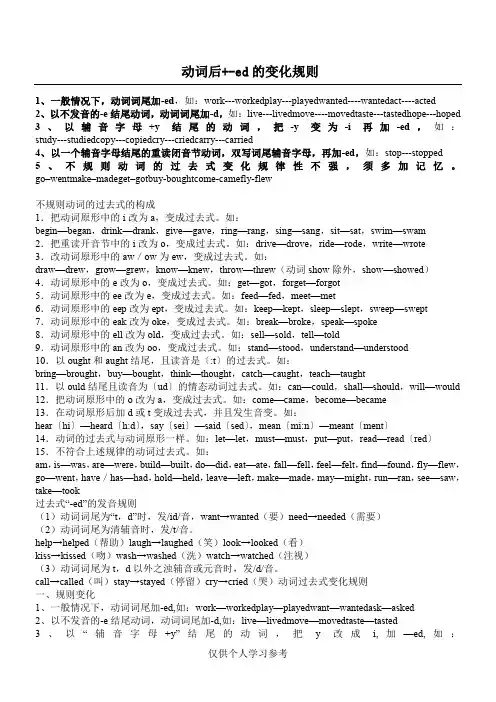
动词后+-ed的变化规则1、一般情况下,动词词尾加-ed,如:work---workedplay---playedwanted----wantedact----acted2、以不发音的-e结尾动词,动词词尾加-d,如:live---livedmove----movedtaste---tastedhope---hoped3、以辅音字母+y结尾的动词,把-y变为-i再加-ed,如:study---studiedcopy---copiedcry---criedcarry---carried4、以一个辅音字母结尾的重读闭音节动词,双写词尾辅音字母,再加-ed,如:stop---stopped5、不规则动词的过去式变化规律性不强,须多加记忆。
go–wentmake–madeget–gotbuy-boughtcome-camefly-flew1begin—23draw—)45678910.以bring—11.以—would 1213hear〔hi14〕15am,is——flew,go—went—saw,take—过去式“-(1)动词词尾为“t,d”时,发/id/音,want→wanted(要)need→n eeded(需要)(2)动词词尾为清辅音时,发/t/音。
help→helped(帮助)laugh→laughed(笑)look→looked(看)kiss→kissed(吻)wash→washed(洗)watch→watched(注视)(3)动词词尾为t,d以外之浊辅音或元音时,发/d/音。
call→called(叫)stay→stayed(停留)cry→cried(哭)动词过去式变化规则一、规则变化1、一般情况下,动词词尾加-ed,如:work—workedplay—playedwant—wantedask—asked2、以不发音的-e结尾动词,动词词尾加-d,如:live—livedmove—movedtaste—tasted3、以“辅音字母+y”结尾的动词,把y改成i,加—ed,如:study—studiestry—triedcopy—copiedcarry—carried4、重读闭音节动词,双写词尾辅音字母,再加—ed,如:stop—stopped二、不规则变化isam—wasare—weredo—didhavehas—hadgo—wentmeet—metcome—cametake—tooksteal—stoleeat —atefly—fliewrun—ransee—sawsay—saidmake—madefind—foundstand—stood sit—satsing—sangdrink—drankgive—gavering—rangswim—swam write—wroteride—rodedrive—drovedraw—drewgrow—grewknow—knewget—gotforget—forgotsweep—sweptkeep—keptsleep—sleptspeak—spokebreak—broketell—buy—can—1234、[t][d]1,stand—2.以-e(1write—having,save—(2)以die—(3)以see——eyeing (4)以sue—suing,imbue—imbuing,construe—construing,pursue—pursuing,rue—ruing有时,词尾e可去掉也可保留:glue—gluing或glueing,cue—cuing或cueing,blue—blueing或bluing,true—truing或trueing,clue—clueing或cluing3.以一元音加一辅音结尾的动词(1)如果动词最后一音节为重读闭音节,最后一个字母需要重复:run—running,stop—stopping,hop—hopping,plan—planning,star—starring,control—controlling 但辅音x是个例外,无需重复(x其实起着两个辅音的作用):tax—taxing,relax—relaxing(2)如果动词最后一个音节为次重读音节,最后一个字母有时也重复:kidnap—kidnapping或kidnaping,program—programming或programing(3)如果动词最后一个音节为非重读音节,最后一个字母大多无需重复:open—opening,offer—offering,audit—auditing但在有些动词中,重复或不重复均可:worship—worshiping或worshipping,focus—focusing或focussing,cancel—canceling或cancelling,travel—traveling或travelling以非重读的-el结尾的动词加-ing时,英国英语习惯于重复词尾l,而美国英语则习惯于不重复1。

动词过去式、过去分词变化规则一、规则变化:1. 一般在动词原形后加-ed look -> looked; need -> needed2. 以-e结尾的动词加-d move -> moved3. 以辅音字母加y结尾的动词,变y为i,再加-ed carry -> carried; study -> studied4. 以元音字母加y结尾的词,直接加-ed stay -> stayed; play -> played5.末尾只有一个辅音字母的重读闭音节词,双写该辅音字母,再加-ed stop -> stopped; regret -> regretted(但fix的过去式和过去分词x不双写,为fixed)6. 以-r音节结尾的词,双写r字母,再加-ed refered -> referred; prefer -> preferred二、不规则变化英语不规则动词记忆表1.AAA动词原形过去式过去分词cost[k?st]cost[k?st]cost[k?st]花费cut[k?t]cut[k?t]cut[k?t]割,切hurt[h?:t]hurt[h?:t]hurt[h?:t]受伤hit[hit]hit[hit]hit[hit]打,撞let[let]let[let]let[let]让put[put]put[put]put[put]放下read[ri:d]read[ri:d]read[ri:d]读set[set]set[set]set[set]安排,安置spread[spred]spread[spred]spread[spred]展开,传播,涂spit[spit]spit/spat[spit]spit/spat[spit]吐痰,shut[??t]shut[??t]shut[??t]关上, 闭起,停止营业2.ABB动词原形过去式过去分词beat[bi:t]beat[bi:t]beaten['bi:tn] 打败3.ABA动词原形过去式过去分词become[bi'k?m]became[bi'keim]become[bi'k?m]变come[k?m]came[keim]come[k?m]来run[r?n]ran[r?n]run[r?n]跑4.ABB(1)在动词原形后加一个辅音字母d, t或ed构成过去式或过去分词。

英语变形规律总结英语单词的变形规律可以总结为以下几个方面:1. 名词的复数形式英语中大部分名词的复数形式是在词尾加上-s,例如:book-books, cat-cats, dog-dogs等。
但也有一些名词有不规则的复数形式,例如:child-children, mouse-mice, foot-feet等。
2. 动词的时态变化英语中的动词有三种基本时态:现在时、过去时和将来时。
在现在时,动词原形和第三人称单数形式是一样的,例如:I walk to school. He walks to school. 在过去时,大部分动词的过去式是在原形后加-ed,例如:I walked to school yesterday. He watched TV last night. 但也有一些动词的过去式是不规则的,例如:go-went, eat-ate等。
在将来时,动词前要加will或shall,例如:I will go to school tomorrow. They shall come to visit us next week.3. 形容词和副词的比较级和最高级形式形容词和副词的比较级和最高级形式都是通过在词尾加上-er和-est来表示的。
例如:big-bigger-biggest, fast-faster-fastest。
但也有一些形容词和副词的比较级和最高级形式是不规则的,例如:good-better-best, well-better-best等。
4. 不规则动词的变化规律在英语中,有一些动词的变化规律是不规则的,例如:go-went-gone, eat-ate-eaten等。
这些动词的过去式和过去分词形式都不是在原形后加-ed,而是需要记忆。
总之,英语单词的变形规律需要仔细学习和记忆,只有通过大量的练习才能掌握得更加熟练。
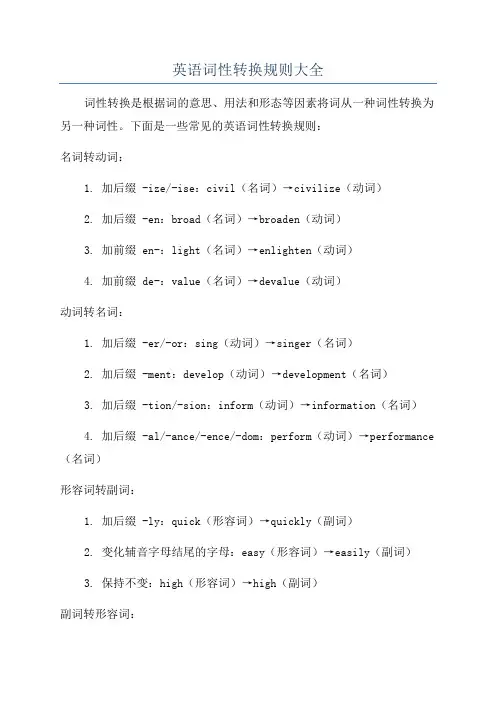
英语词性转换规则大全
词性转换是根据词的意思、用法和形态等因素将词从一种词性转换为另一种词性。
下面是一些常见的英语词性转换规则:
名词转动词:
1. 加后缀 -ize/-ise:civil(名词)→civilize(动词)
2. 加后缀 -en:broad(名词)→broaden(动词)
3. 加前缀 en-:light(名词)→enlighten(动词)
4. 加前缀 de-:value(名词)→devalue(动词)
动词转名词:
1. 加后缀 -er/-or:sing(动词)→singer(名词)
2. 加后缀 -ment:develop(动词)→development(名词)
3. 加后缀 -tion/-sion:inform(动词)→information(名词)
4. 加后缀 -al/-ance/-ence/-dom:perform(动词)→performance (名词)
形容词转副词:
1. 加后缀 -ly:quick(形容词)→quickly(副词)
2. 变化辅音字母结尾的字母:easy(形容词)→easily(副词)
3. 保持不变:high(形容词)→high(副词)
副词转形容词:
1. 去掉后缀 -ly并加后缀 -al:actively(副词)→active(形容词)
2. 去掉后缀 -ly并加后缀 -y:quickly(副词)→quick(形容词)动词转副词:
1. 加后缀 -ly:slow(动词)→slowly(副词)
2. 保持不变:run(动词)→run(副词)
以上是一些常见的英语词性转换规则,但并不是所有词都能完全按照
这些规则进行转换,还需根据具体情况灵活运用。
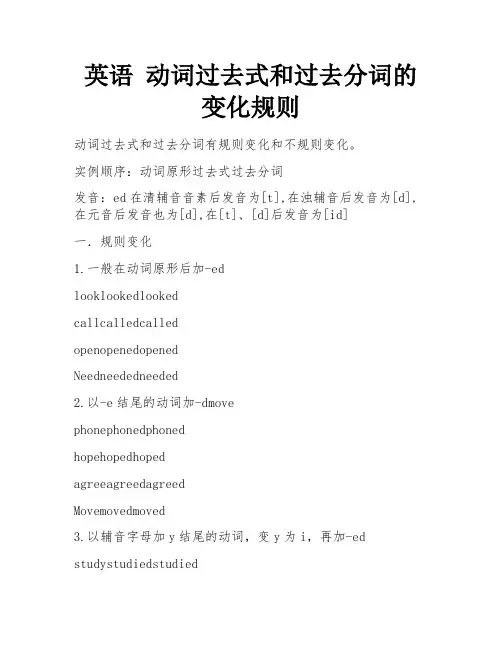
英语动词过去式和过去分词的变化规则动词过去式和过去分词有规则变化和不规则变化。
实例顺序:动词原形过去式过去分词发音:ed在清辅音音素后发音为[t],在浊辅音后发音为[d],在元音后发音也为[d],在[t]、[d]后发音为[id]一.规则变化1.一般在动词原形后加-edlooklookedlookedcallcalledcalledopenopenedopenedNeedneededneeded2.以-e结尾的动词加-dmovephonephonedphonedhopehopedhopedagreeagreedagreedMovemovedmoved3.以辅音字母加y结尾的动词,变y为i,再加-edstudystudiedstudiedcarrycarriedcarriedtrytriedtried4.以原音字母加y结尾的词,直接加-edplayplayedplayedenjoyenjoyedenjoyedstaystayedstayed5.末尾只有一个辅音字母的重读闭音节词,双写该辅音字母,再加-edstopstoppedstoppedplanplannedplannedfitfittedfitted6.以-r音节结尾的词,双写r字母,再加-edpreferpreferredpreferredreferreferredreferred二.不规则变化:英语中有些动词的过去式和过去分词形式变化不规则,可分为五种情况。
1.动词原形、过去式和过去分词完全同形。
cut(切)cutcuthit(打)hithitcast(扔)castcasthurt(伤害)hurthurtput(放)putputlet(让)letletshut(关)shutshutcost(花费)costcostset(放)setsetrid(清除)ridrid2.过去式与过去分词完全同形。
find(找到)foundfoundpay(支付)paidpaidleave(离开)leftleftlend(借出)lentlentmeet(遇见)metmetkeep(保持)keptkeptlose(丢失)lostlostteach(教)taughttaughtsit(坐)satsatlead(引导)ledledwin(赢)除)wonwon3.动词原形与过去分词同形e(来)cameerun(跑)ranrunbee(成为)becamebee4.动词原形、过去式、过去分词形式完全不同。
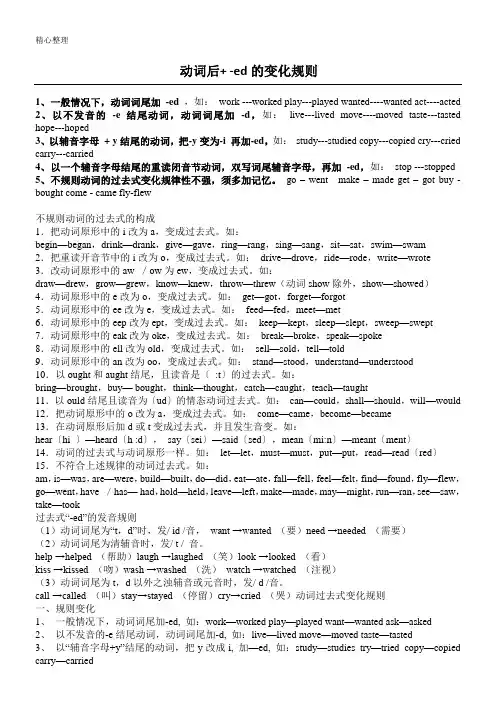
动词后+ -ed的变化规则1、一般情况下,动词词尾加-ed,如:work ---worked play---played wanted----wanted act----acted2、以不发音的-e 结尾动词,动词词尾加-d,如:live---lived move----moved taste---tasted hope---hoped3、以辅音字母+ y结尾的动词,把-y变为-i 再加-ed,如:study---studied copy---copied cry---cried carry---carried4、以一个辅音字母结尾的重读闭音节动词,双写词尾辅音字母,再加-ed,如:stop ---stopped5、不规则动词的过去式变化规律性不强,须多加记忆。
go – went make – made get –got buy - bought come - came fly-flew1begin—23draw—)45678910.以bring—11.以—would 1213hear〔hi14〕15am,is——flew,go—went—saw,take—took过去式“-ed”的发音规则(1)动词词尾为“t,d”时,发/ id /音,want →wanted (要)need →needed (需要)(2)动词词尾为清辅音时,发/ t / 音。
help →helped (帮助)laugh →laughed (笑)look →looked (看)kiss →kissed (吻)wash →washed (洗)watch →watched (注视)(3)动词词尾为t,d以外之浊辅音或元音时,发/ d /音。
call →called (叫)stay→stayed (停留)cry→cried (哭)动词过去式变化规则一、规则变化1、一般情况下,动词词尾加-ed, 如:work—worked play—played want—wanted ask—asked2、以不发音的-e结尾动词,动词词尾加-d, 如:live—lived move—moved taste—tasted3、以“辅音字母+y”结尾的动词,把y改成i, 加—ed, 如:study—studies try—tried copy—copied carry—carried4、重读闭音节动词,双写词尾辅音字母,再加—ed, 如:stop—stopped二、不规则变化is am—was are—were do—did have has—had go—went meet—met come—came take—took steal—stole eat—ate fly—fliew run—ran see—saw say—said make—made find—found stand—stood sit—sat sing—sang drink—drank give—gave ring—rang swim—swamwrite—wrote ride—rode drive—drovedraw—drew grow—grew know—knewget—got forget—forgotsweep—swept keep—kept sleep—sleptspeak—spoke break—broketell—told sell—soldbuy—bought think—thought catch—caught teach—taught build—builtcan—1、2、3、4、[t][d]1,stand—2.以-e(1write—having,save—(2)以die—(3)以see——eyeing (4)以sue—suing,imbue—imbuing,construe—construing,pursue—pursuing,rue—ruing有时,词尾e可去掉也可保留:glue—gluing或glueing,cue—cuing或cueing,blue—blueing或bluing,true—truing或trueing,clue—clueing或cluing3.以一元音加一辅音结尾的动词(1)如果动词最后一音节为重读闭音节,最后一个字母需要重复:run—running,stop—stopping,hop—hopping,plan—planning,star—starring,control—controlling 但辅音x是个例外,无需重复(x其实起着两个辅音的作用):tax—taxing,relax—relaxing(2)如果动词最后一个音节为次重读音节,最后一个字母有时也重复:kidnap—kidnapping或kidnaping,program—programming或programing(3)如果动词最后一个音节为非重读音节,最后一个字母大多无需重复:open—opening,offer—offering,audit—auditing但在有些动词中,重复或不重复均可:worship—worshiping或worshipping,focus—focusing或focussing,cancel—canceling或cancelling,travel—traveling或travelling以非重读的-el结尾的动词加-ing时,英国英语习惯于重复词尾l,而美国英语则习惯于不重复1。
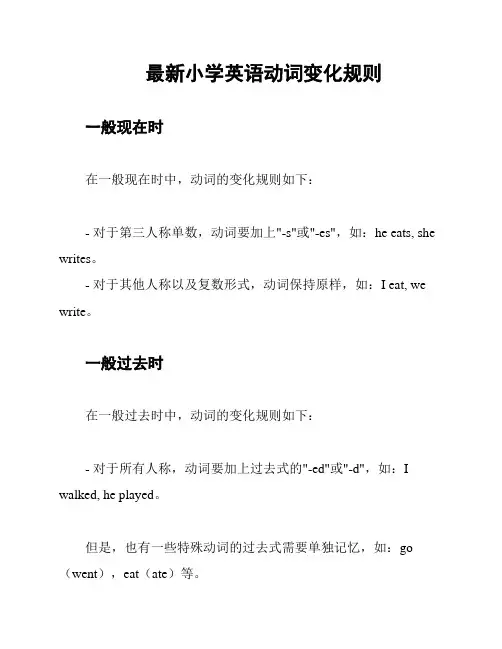
最新小学英语动词变化规则
一般现在时
在一般现在时中,动词的变化规则如下:
- 对于第三人称单数,动词要加上"-s"或"-es",如:he eats, she writes。
- 对于其他人称以及复数形式,动词保持原样,如:I eat, we write。
一般过去时
在一般过去时中,动词的变化规则如下:
- 对于所有人称,动词要加上过去式的"-ed"或"-d",如:I walked, he played。
但是,也有一些特殊动词的过去式需要单独记忆,如:go (went),eat(ate)等。
现在进行时
在现在进行时中,动词的变化规则如下:
- 动词要加上"-ing",如:I am eating, they are playing。
然而,也有一些特殊动词在进行时态时会产生变化,如:run (running),sit(sitting)等。
动词时态变化总结
总体而言,小学英语动词变化规则基本上遵循以下模式:
- 一般现在时:第三人称单数加上"-s"或"-es",其他人称和复数
形式保持原样。
- 一般过去时:动词加上过去式的"-ed"或"-d",特殊动词单独
记忆。
- 现在进行时:动词加上"-ing",特殊动词在进行时态时有变化。
记住这些变化规则,可以帮助学生正确地使用和变化英语动词的时态。

五段动词变化规则在英语语法中,五段动词是指根据不同时态和人称而产生变化的一类动词。
这些动词的变化规则非常规范和有序,是学习英语时的重点之一。
掌握五段动词的变化规则对于正确使用英语时态和人称十分关键。
本文将详细介绍五段动词变化规则,以帮助你更好地理解和使用这些动词。
一、五段动词的定义五段动词是指常规动词的一种类型,包括绝大多数英语动词,如“walk”(走),“eat”(吃),“go”(去)等。
这些动词在特定的时态和人称下发生变化,通常被分为五个不同的形式。
二、五段动词的变化形式五段动词的变化形式包括:原形(infinitive)、过去式(simple past)、过去分词(past participle)、现在分词(present participle)和第三人称单数现在时(third person singular present)。
下面将详细介绍每个变化形式的规则和示例。
1. 原形(infinitive)原形即动词的基本形式,常以to开头,例如“to walk”(走),“to eat”(吃)。
“to”本身不是动词的一部分,只是表明所使用的是动词形式。
原形通常用来作为动词的主语或宾语。
2. 过去式(simple past)过去式表示动作或状态在过去发生或存在。
通常在动词原形后加上-ed或-d,如“walked”(走过),“ate”(吃过),除了某些特殊规则的例外。
例如,以-e 结尾的动词只需加-d,如“love”(爱)的过去式为“loved”(爱过)。
3. 过去分词(past participle)过去分词用于完成时态和被动语态,通常在动词原形后加上-ed或-d,如“walked”(走过),“eaten”(吃过)。
同样地,以-e结尾的动词只需加-d,如“loved”(爱过)。
4. 现在分词(present participle)现在分词表示正在进行的动作或状态。
通常在动词原形后加上-ing,如“walking”(正在走),“eating”(正在吃)。
动词的第三人称单数现在式变化规则:1)一般由动词原形加-sget-gets play-plays2)以㊀结尾的动词,加-slike-likes make-makes3)以0结尾的动词加-esgo-goes do-does以s, x, ch, sh等字母结尾的动词,后面加-eskiss-kisses fix-fixes teach-teaches fish-fishes4)以辅音字母加丫结尾的动词,先将y变i,再加-es fly-flies study-studies5) have —has一般现在时主语+动词原型VI have a friend. You have a friend. We have a friend. They have a frie nd. 主语(第三人称单数)+动词V (三单)She / He / It has a friend.Tom / My mother has a friend.名词单数变复数口诀(一)规则变化名词单数变复数,直接加-s占多数;s, x, z, ch, sh来结尾,直接加上-es ;词尾是f或fe,加-s之前先变ve;辅母+ y在词尾,把y变i再加-es;词尾字母若是o,常用三个已足够,要力口-es 请记好,hero, tomato, potato。
(二)不规则变化男人女人a变e,鹅足牙oo变ee ;老鼠虱婆也好记,ous变ic;孩子加上ren,鱼鹿绵羊不用变。
This---these(这些)that -- those(那些)【解说】1.英语名词有单数和复数的区别,单数表示“一”,复数表示“多于一。
”名词由单数变复数,多数是规则的变,直接加-s,例如:book— books, girl — girls。
但以-s, -z, -x, -ch, -sh 结尾的名词,变成复数时加-es, 例如:bus—buses, buzz —buzzes, box— boxes, watch — watches, brush — brushes2.-f(e)结尾的名词单数变复数歌诀:①树叶半数自已黄,妻子拿刀去割粮,架后窜出一只狼,就像强盗逃命忙。
动词变为名词的一般规则如下:
1.词形不变,词性改变。
例如:
work, study, water, plant等可以用作动词,也可以用作名词。
2. 一些动词在词尾加上-er或-or之后就变成了表示“某一类人”的名词。
例如:
work—worker, teach—teacher, sing—singer, jump—jumper, play—player, learn—learner, visit—visitor, invent—inventor等。
注意:1)以不发音的e结尾的动词,在词尾加-r。
例如:drive—driver, write—writer等。
2)以重读闭音节结尾,且末尾只有一个辅音字母的动词,应双写末尾的辅音字母,再加-er。
例如:run—runner, win—winner,begin—beginner等。
3. 在动词词尾加-ing变成名词(方法与动词变为现在分词的方法相同)。
例如:
meet—meeting, build—building, wait—waiting, wash—washing, swim—swimming, shop—shopping, begin—beginning等。
动名词的规那么变化1 一般情况下,直接在动词后加-ing 〔现在进行时〕eg: work ---- working study ----- studying2 动词以不发音的-e结尾,要去-e加-ing take ----- taking make ----- making3 重读闭音节的动词,要双写词尾字母,再加-ing cut ----- cutting put begin4 以-ie结尾的动词,把变成y再加-ing lie ----- lying tie ----- tying die ----- dying英语语共有十六个时态、四个体。
〔注:四个体为——一般、进行、完成、完成进行。
〕英语中的四个体相当于法语、西班牙语以及所有印欧语系罗曼语族中的式,如:直陈式,命令式等。
〔1〕一般现在时根本形式〔以do为例〕:主动态:do;被动态:doing、be done;过去时:did;第三人称单数:does〔主语为非第三人称单数〕;肯定句:主语+动词原形+其他;否认句:主语+don‘t+动词原形+其他;一般疑问句:Do+主语+动词原形+其他。
肯定答复:Yes,+主语+do.否认答复:No,+主语+don't.特殊疑问句:疑问词+一般疑问句语序〔2〕一般过去时be动词+行为动词的过去式was/were+not;在行为动词前加didn‘t,同时复原行为动词was或were放于句首;用助动词do的过去式did提问,同时复原行为动词〔3〕一般将来时am/are/is+going to+dowill/shall+doam/is/are/about to + doam/is/are to + do一般将来时的表达方法be going to +动词原形be +不定式,be to+动词原形,be about to +动词原形be able to +不定式be about to+动词原形(4)过去将来时be〔was,were〕going to+动词原形be〔was,were〕about to+动词原形be〔was,were〕to+动词原形肯定句:主语+be〔was,were〕going to+动词原形~.否认句:主语+be〔was,were〕not going to+动词原形~.疑问句:Be〔Was,Were〕+主语+going to+动词原形~?肯定句:主语+would〔should〕+动词原形~.否认句:主语+would〔should〕not+动词原形~.疑问句:Would〔Should〕+主语+动词原形~?(5)现在进行时主语+be+动词ing〔现在分词〕形式第一人称+am+doing+sth第二人称+are+doing +sth第三人称+is+doing+sth(6)过去进行时肯定句:主语+was/were+doing+其它否认句:主语+was/were+not+doing+其它一般疑问句及答语:Was/Were+主语+doing+其它答语:Yes,I was./No,I wasn't.特殊疑问句:特殊疑问词+was/were+主语+doing+其它(7)将来进行时动词be的将来时+现在分词(8)现在完成时根本结构:主语+have/has+过去分词(done)①肯定句:主语+have/has+过去分词+其他②否认句:主语+have/has+not+过去分词+其他③一般疑问句:Have/Has+主语+过去分词+其他④特殊疑问句:特殊疑问词+一般疑问句〔have/has+主语+过去分词+其他(9)过去完成时根本结构:主语+had+过去分词(done)①肯定句:主语+had+过去分词+其他②否认句:主语+had+not+过去分词+其他③一般疑问句:Had+主语+过去分词+其他肯定答复:Yes,主语+had否认答复:No,主语+hadn't④特殊疑问句:特殊疑问词+一般疑问句〔had+主语+过去分词+其他〕语法判定:〔1 〕by + 过去的时间点。
英语动词三单变化规则英语动词三单变化规则是指在英语中,动词在第三人称单数时的变化规则。
这个规则对于初学者来说非常重要,因为英语是一种频繁使用第三人称单数的语言。
在学习这个规则时,我们需要理解它的规律及其中的例外,这样才能正确地使用英语动词。
一、规则。
大部分动词在第三人称单数中都需要在词尾加上-s或-es。
下面是一些具体例子:1.主动态动词:He walks to work every day. (他每天走路上班。
)。
She cooks a delicious meal for her family. (她为家里做了一顿美味的饭菜。
)。
The dog barks all night. (狗整晚都在叫。
)。
2.被动态动词:The house is cleaned every week. (这个房子每周都会打扫。
)。
The dishes are washed after dinner. (餐后洗碗。
)。
The car is repaired by a mechanic. (汽车由技工修理。
)。
二、变化规则。
1.以辅音字母+y结尾的动词变化。
如果一个动词以辅音字母+y结尾,那么在第三人称单数中,将y改为i再加上-es。
下面是一些例子:try – tries (尝试)。
fly – flies (飞)。
study – studies (学习)。
2.以字母o结尾的动词变化。
如果一个动词以字母o结尾,那么在第三人称单数中,通常需要在词尾加上-es。
如果一个动词以字母o结尾且前面有元音字母,则直接加-s 而不是-es。
下面是一些例子:go – goes (去)。
do – does (做)。
3.以辅音字母+o结尾的动词变化。
如果一个动词以辅音字母+o结尾,那么在第三人称单数中,需要在词尾添加-es。
下面是一些例子:go – goes (去)。
echo – echoes (回声)。
mango – mangoes (芒果)。
英语动词第三人称单数变化规则
一般情况下,英语动词在第三人称单数时,会在原来的词尾加上-s
或-es。
1. 词尾是不发音的辅音字母结尾的动词,在第三人称单数时加-s。
例如:like(喜欢)→ likes(喜欢), watch(观看)→ watches(观看)。
2. 词尾是发音的辅音字母结尾的动词,在第三人称单数时加-es。
例如:fix(修理)→ fixes(修理), match(匹配)→ matches(匹配)。
3. 以字母-y结尾,而在y之前是辅音字母的动词,在第三人称单数
时将-y变为-i,再加-es。
例如:study(学习)→ studies(学习),
try(尝试)→ tries(尝试)。
4. 以字母-y结尾,而在y之前是元音字母的动词,直接加-s。
例如:play(玩)→ plays(玩), stay(停留)→ stays(停留)。
5. 以字母-o结尾的动词,一般在第三人称单数时加-es。
例如:go (去)→ goes(去), do(做)→ does(做)。
英语动词变形容词规则口诀
动词变形容词规则是学习英语词汇必备的一部分。
掌握了这些规则,我们就能够准确地将动词转化为形容词,丰富我们的词汇量。
下
面是一些常见的动词变形容词规则,希望能够帮助大家更好地学习和
记忆。
1. 一般情况下,动词在变形容词时,在词尾加上“-ing”。
例如:boring(无聊的)、interesting(有趣的)。
2. 如果动词以辅音字母+ “e”结尾,则去掉“e”,再加上“-ing”。
例如:taking(拿着的)、making(制作的)。
3. 如果动词以重读闭音节结尾(辅音字母 + 单元音 + 辅音字母),并且末尾只有一个辅音字母,则双写最后一个辅音字母,再加
上“-ing”。
例如:running(奔跑的)、swimming(游泳的)。
4. 如果动词以“-ie”结尾,则改变“-ie”为“-y”,再加上
“-ing”。
例如:flying(飞行的)、crying(哭泣的)。
5. 如果动词以“-ee”结尾,则直接加上“-ing”,不做其他变化。
例如:agreeing(同意的)、seeing(看见的)。
6. 一些不规则变形的动词需要特殊记忆,请多加注意。
例如:going(去的)、doing(做的)。
以上就是一些常见的动词变形形容词规则。
通过不断的练习和记忆,我们可以迅速掌握这些规则,丰富我们的词汇量。
希望以上内容
对大家有所帮助,加油!。
外教一对一
英语动词的变化规则
1) 代词及be动词
主格 I we you you she/he/it they
宾格 me us you you her/him/it them
代词所有格 my our your your her/his/its their
名词性代词 mine ours yours yours hers/his/its theirs
be动词现在时 Am are are are is are
be动词过去时 was were were were was were
2) 名词的复数
规则变化的名词复数形式
规则1 一般情况+s e.g. shell→shells toy→toys
规则2 以s, x, ch, sh结尾+es e.g. fox→foxes church→churches
规则3 以o结尾+s或+es e.g. radio→radios potato→potatoes
规则4 以f, fe结尾的,变f, fe为ves e.g. life→lives half→halves
规则5 以辅音字母+y结尾,变y为i+es e.g. sky→skies study→studies
3) 动词的第三人称单数形式
规则1 一般情况+s e.g. like-likes, look-looks
规则2 以s, x, ch, sh和o结尾+es e.g. do-does, catch-catches
规则3 以辅音字母+y结尾,变y为i+es e.g. carry-carries, fly-flies
4) 动词现在分词
规则1 一般动词加-ing e.g. look-looking, read-reading, play-playing
规则2 以不发音的字母结尾的单词去e加-ing e.g. make-making, take-taking, arrive-arriving
外教一对一 规则3 重读闭音节词结尾,即单词中只有一个元音字母,其后紧跟一个辅音字母的词,双写辅音字母再加-ing e. g. run-running, sit-sitting, get-getting, swim-swimming, stop-stopping
5) 动词过去式
规则动词变化
规则1 一般动词加-ed e.g. look-looked, watch-watched, play-played
规则2 以e结尾的加-d e.g. make-maked, arrive-arrived
规则3 以辅音字母y结尾的变y为i加-ed cry-cried, carry-carried
规则4 重读闭音节词结尾,即单词中只有一个元音字母,其后紧跟一个辅音字母的词,双写辅音字母再加-ed stop-stopped
过去式的读音
在清辅音后面(除外)读/t/ e.g. walked, jumped
在浊辅音和元音后读/d/ e.g. washed, watched
在/t/,/d/后读/id/ e.g. waited, hated
6) 形容词和副词的比较级和最高级
比较级
规则1 一般加-er e.g. high-higher
规则2 以e结尾加-r nice-nicer
规则3 以辅音字母加y结尾,变y为i再加-er busy-busier
规则4 重读闭音节结尾,双写辅音字母再加-er fat-fatter
最高级
规则1 一般加-est e.g. high-highest
规则2 以e结尾加-st nice-nicest
规则3 以辅音字母加y结尾,变y为i再加-est busy-busiest
外教一对一 规则4 重读闭音节结尾,双写辅音字母再加--est fat-fattest
7) 常见缩写:
is='s I am=I'm are='re
is not=isn't /iznt/ are not=aren't /a:nt/
do not=don't
does not=doesn't
was='s
did not=didn't
can not=can't
have='ve
has='s
have not=haven't
has not=hasn't
will='ll
will not=won't
shall not=shan't。